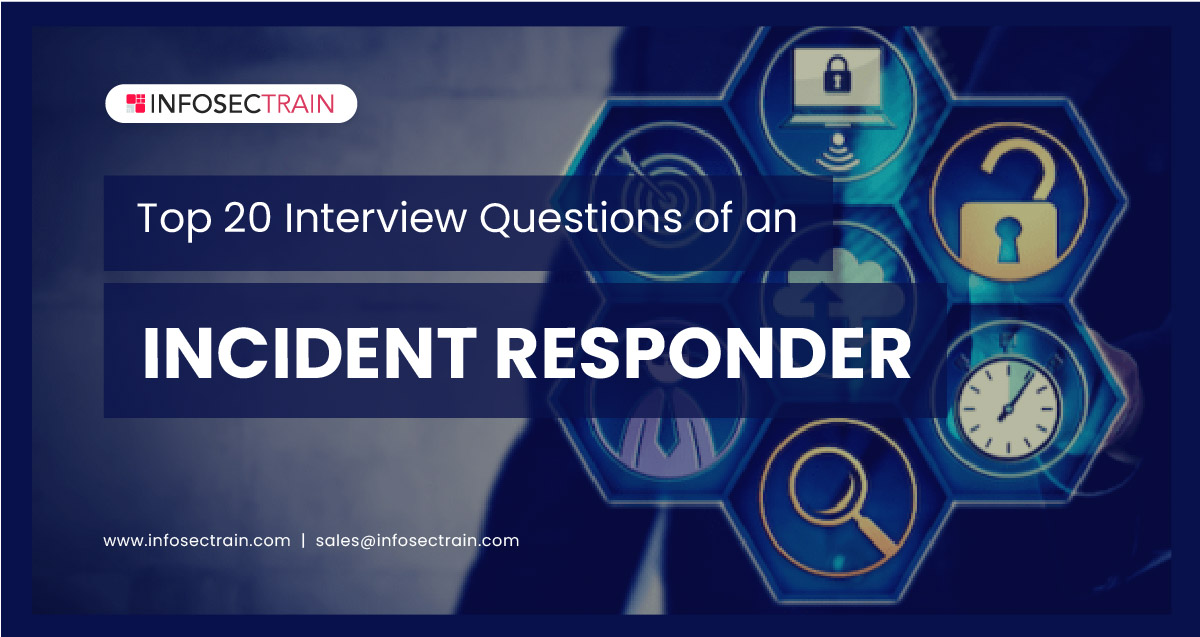Top 20 Interview Questions of an Incident Responder
Incident response is a technique for dealing with security breaches, cyberattacks, and data theft in an organized manner. The goal of the incident response approach is to find, manage, and reduce the cost of a cyber threat or a significant event. When an organization encounters a problem, it works promptly to resolve it and takes the necessary steps to prevent future problems. Many large and small organizations have Security Incident Responders on board. These professionals are needed by both non-profits and government organizations, who are responsible for mitigating damage caused by any cyber attacks in an organization.

So in this article, let’s discuss some interview questions that will help you crack the interview and land your dream job.
1: What are the key responsibilities of an Incident Responder in an organization?
An Incident Responder is the person who deals with cyber threats for an organization. They protect and prevent major threats or attacks from happening. Following are some of the responsibilities of an Incident Responder:
- Identify any potential threat or vulnerability in a network system.
- Create a framework of processes for dealing with an incident.
- Effectively monitor systems and apps for any malicious activity.
- Provide well-written incident reports to representatives of the authorized management team.
2. What is a common way for organizations to be affected?
A DoS (Denial of Service) attack is the most common way to overflow a system with traffic, causing computers, routers, and other network equipment to overflow. The high volume of traffic causes networks to collapse and servers to malfunction.
3: What security software can you use to monitor the network?
Snort for intrusion detection, Checkpoint for firewall, and Symantec or McAfee for malware are some security software used to monitor the network system.
4: As an Incident Responder, what types of security breaches might you encounter?
The following are some examples of security flaws that you may encounter in your day-to-day life:
- Phishing attack
- Denial-of-Services attack
- Ransomware attack
- SQL injections
- Malware attacks
5: What are the NIST (National Institute of Standards and Technology) defined steps of the incident response lifecycle?
The NIST framework comprises five key phases: identify, protect, detect, respond, and recover.
- Identify: In this phase, we develop organizational awareness of the different security issues relating to networks, information assets, information, and activities.
- Protect: This phase involves implementing protections to improve the delivery of essential infrastructure services.
- Detect: This phase focuses on creating and executing procedures for detecting security incidents
- Respond: This phase also involves creating and implementing solutions that address identified incidents.
- Recover: In this phase, we focus on creating and implementing a solution to get the organization back up and running after the incident.
6: What should you do when you suspect that a network has been compromised?
Examine system records, such as firewalls and server log data to determine which files or services were compromised. Deploy antimalware applications to see any present risks to the systems. Make a strategic plan to prevent this problem in the future.
7: What plan would you need to repair a failed system?
Answer: A Disaster Recovery Plan (DRP) is the appropriate approach to be followed when you need to repair a failed system. This plan describes all the procedures and concerns to make while restoring a failed system.
8: How can you encrypt email to protect workplace communications?
Answer: PGP (Pretty Good Privacy) is an encryption program that allows you to encrypt email using authentication methods. To ensure that only the authorized access can view the email, you employ a public-private pair of keys between the sender and the recipient.
9: Define port scanning, and why would you use it?
A technique of scanning a computer or network to see whether networking ports are active or inactive is known as port scanning. Port scanners are widely used and provide Incident Responders with a better understanding of the network’s actual status. When an Incident Responder is trying to figure out why an application isn’t operating as it should or to see if there are any unwanted accesses to a website or device, port scanners come in useful.
10: Explain an Incident Response Plan?
An Incident Response Plan (IRP) is a defined collection of techniques that supports Incident Responders in detecting and responding to an incident that has occurred.
11: What are the benefits of having an Incident Response Plan?
Cyberattacks can affect any organization’s system or network. An incident response plan can assist in minimizing cyber threats and combating severe cyberattacks in such circumstances.
12: What are some of the incident response tools?
Following are some of the incident response tools:
- LogRhythm: It’s a Modern SIEM (Security Information and Event Management) platform that includes cyber security solutions, UEBA (User and Entity Behavior Analytics), NDR (Network Detection and Response), and SOAR (Security Orchestration, Automation, and Response).
- Sumo Logic: This tool is ideally suited for defending cloud infrastructures and complex applications. It offers the necessary analytics and insights.
- InsightIDR: This SaaS (Software-as-a-Service) SIEM (Security Information and Event Management) tool is designed to detect and respond to emerging threats.
- CB Response: It provides real-time reaction capabilities and professional threat assessments to incident response teams.
13: Explain SIEM?
A SIEM (Security Information and Event Management) collects data from various sources and transforms it into useful information. It can also detect and restrict access to existing threats, depending on how the system is configured in multiple situations.
14: What is Automated Incident Response?
Automated Incident Response systems assist professionals in reducing the time it takes to identify and isolate a vulnerability by automating operations that would take a long time to execute.
15: Explain the Cross-site Scripting (XSS) attack?
Cross-site Scripting (XSS) attack is a cybersecurity vulnerability that allows the attacker to modify user engagement with a compromised service. It enables an attacker to get around the exact source policy, which keeps websites separate from one another.
16: Describe a security incident?
Security incidents are occurrences within an organization that may indicate a cybersecurity threat or attack. A critical security process is detecting and responding to events promptly.
17: What is the main difference between NIDS and HIDS?
The NIDS (Network Intrusion Detection System) and HIDS (Host Intrusion Detection System) are the intrusion detection types.
| NIDS | HIDS |
|
|
|
|
18: How important is a vulnerability assessment?
A vulnerability is a fault or weakness in a network or software that can be misused to gain unauthorized access, raise privileges, or cause a system or device to stop working. As cyber-attacks become more prevalent in our everyday lives, it is critical to conduct daily, weekly, or monthly assessments to monitor our system’s weak areas. The majority of these assessments are carried out by the SIEM, although some are carried out manually.
19: How would you identify a cloud-based storage-related security incident?
An incident responder can identify storage-related security problems in the cloud by monitoring and completely examining the metadata of file systems and storage devices for malicious programs.
20: List some of the network security tools?
Network security tools and resources that protect organizational confidential information, credibility, and data from unauthorized access. Here are some network security tools:
- Metasploit
- Wireshark
- Nessus
- Aircrack
- Snort
- Argus
- Cain and Abel
- Tcpdump
- Splunk
Become an Incident Responder with InfosecTrain
These questions will aid you in your interview preparation when you are ready to pursue a career as an Incident Responder. These aren’t the only questions you’ll be asked at an interview; the difficulty level of the questions will be different depending on the position you’re applying for. InfosecTrain is here to help you in your incident responder career. Enroll yourself today in our EC-Council Certified Incident Handler training course to strengthen your knowledge and skills.







 1800-843-7890 (India)
1800-843-7890 (India)